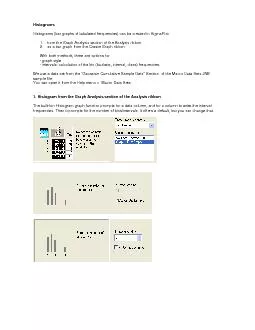

8910111213 Count 246121416 Count Histogramnormal 101 891011121314 Count 46121416 Histogramnormal 101 8910111213 Count 2 Count 1 Histogramnormal 101 8910111213 Count Of course the graph cre ID: 102214
Download Pdf The PPT/PDF document "Histogramnormal (10,1)" is the property of its rightful owner. Permission is granted to download and print the materials on this web site for personal, non-commercial use only, and to display it on your personal computer provided you do not modify the materials and that you retain all copyright notices contained in the materials. By downloading content from our website, you accept the terms of this agreement.
Histogramnormal (10,1) 8910111213 Count 246121416 Count Histogramnormal (10,1) 891011121314 Count 46121416 Histogramnormal (10,1) 8910111213 Count 2 Count 1 Histogramnormal (10,1) 8910111213 Count Of course, the graph created with this special function can be edited and customized like any other SigmaPlot graph. 2. Histogram as a bar graph from the Create Graph ribbon The histograms created with method (1) are equidistant, e.g. each interval has the same width, and their width is determined by the number of intervals. With method (2), you can create histograms with any series of intervals, also those with varying width. Calculate the frequencies first, then create a bar graph to display them. 2.1 Interval frequencies SigmaPlots User-Defined Transform functions help to calculate the interval frequencies automatically. From the worksheet, select Analys�is User-Defined. Enter the transform text, and click Run to execute it. The histogram (range; buckets) function produces a histogram of the values range in a specified range, using a defined interval set. (See: Transform Help, press F1 in the edit window). The range argument must be a single range (indicated with the {} brackets) or a worksheet column. The buckets argument is used to specify either the number of evenly incremented histogram intervals, or both the number and ranges of the intervals. The data for this example are in col(1). Option a) Select the number of intervals: To calculate the frequencies for 7 intervals of equal width col(3) = histogram(col(1); 7)